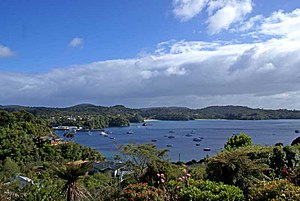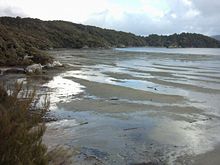Stewart Island
| Stewart Island | ||
|---|---|---|
| Stewart Island satellite image | ||
| Waters | South pacific | |
| Geographical location | 46 ° 59 ′ S , 167 ° 53 ′ E | |
|
|
||
| surface | 1 746 km² | |
| Highest elevation | Mount Anglem 981 m |
|
| Residents | 600 <1 inh / km² |
|
| main place | Oban | |
| View of Oban and Halfmoon Bay | ||
Stewart Island ( Māori : Rakiura ), officially called Stewart Island / Rakiura , is the third largest island in New Zealand . It joins the New Zealand South Island 30 km south . Its area of 1746 km² corresponds to 65.4% of the area of the Saarland .
Origin of name
The Māori call the island Rakiura , which translated into German means "glowing sky". The island got its English name in 1809, when the Scottish cartographer William Stewart was the first officer of the Pegasus to map parts of the south coast of New Zealand and Stewart Island.
geography
Stewart Island is 1746 km² and is barely inhabited. The only settlement is Oban , located in Halfmoon Bay. The place has about 600 inhabitants. The population density of the entire island is 0.36 inhabitants / km². The approximately 70 km × 40 km large island is heavily forested and mountainous. The highest point is Mount Anglem at 981 m. The southernmost point is the South Cape . The coastline is very fragmented, especially by the Paterson Bay , which stretches far into the island's interior. In the Paterson Bay there are several small islands such as Ulva Island and Native Island . Stewart Island is separated from the South Island by the Foveaux Strait , which is considered to be very stormy and in which the now uninhabited Ruapuke Island is located. Due to the warm currents that wash around the island, the climate is quite moderate for the southern location. The winters in particular are relatively mild. Overall, the climate is unstable, humid and windy.
Flora and fauna
The island is home to the Tokoeka or southern striped kiwi ( Apteryx australis ), one of the five species of the kiwi, the New Zealand heraldic bird. Stewart Island is also home to a breeding colony of the rare yellow-eyed penguin .
Titi - the chick of the dark shearwater ( Puffinus griseus ) was already coveted as a source of food by the Māori . A warm current connects the Australian Great Barrier Reef directly with Stewart Island and ensures particularly clear, warm water and a species-rich underwater fauna in the shallow waters off the coast.
Whale strandings
At the end of November 2018, more than 140 pilot whales were stranded .
Discovery and settlement
Small traces of settlement by the Māori can be traced back to the 13th century. In the Māori language, the island was also called Rakiura and Te Punga o te Waka a Maui ( anchor of Maui's canoe ). Overall, they preferred the small island of Ruapuke halfway to the mainland, as it was easier to defend. James Cook was the first European to sight the island when he circumnavigated the South Island in 1770. Assuming that Stewart Island was connected to the mainland, Cook called it the South Cape and continued south.
It was not until February 1809, on a seal hunt trip to a group of islands off New Zealand's South Island, that Captain Eber Bunker (1761–1836) discovered the waterway between New Zealand's South Island and Stewart Island ( Foveaux Strait ) with the Pegasus and recognized that the supposed peninsula was had to be an island. In the reports of that time, however, no name appears for the island. In August of that year, the ship sailed from Port Jackson in Australia along the south coast of the then uninhabited Stewart Island, this time under Captain S. Chace. Also on board was First Officer William Stewart , after whom the island was later named. He mapped parts of the south coast, especially South Port , today's Pegasus Port , and gave the map to the editor of the Oriental Navigator . In 1816 he published the map, using the term Stewart's Island for the first time ; the card was used by the British Navy and merchants until 1840. However, Stewart is sometimes mistakenly referred to as the discoverer of the island or the Foveaux Strait.
During the 19th century there were some European attempts to settle in the hinterland. Settlements with sawmills and fishing stations were established outside Oban. However, due to the remoteness, they usually only lasted a few decades. From 1890 attempts were made to establish a tin mine near Port Pegasus (south coast) . Up to 200 workers were temporarily on site. There were a couple of shops and a post office. Today the ruins can only be reached by boat or by a laborious march across the island.
Transport and tourism
Stewart Island can be reached from the South Island, either from Bluff with a one-hour ferry passage or from Invercargill by propeller plane. Invercargill offers shuttle connections to the ferry in Bluff. The runway on Stewart Island has no terminal buildings and the transfer to Oban is carried out by shuttle buses. There are several hotels, a few shops and now a 6-hole golf course in Oban and the surrounding area. There are no banks.
In 2002, with the establishment of the 1570 km² Rakiura National Park, around 93.5% of the island's area was placed under protection. The island can be measured on various described circular walks. Traces of settlement attempts can often be found along the way. The best known is the Rakiura track , which can be mastered in three to four days. A large proportion of the paths are secured with board walks by the park administration, as the paths, which tend to become muddy, are accordingly sensitive. There are no managed overnight accommodations outside Oban. You can either spend the night in hikers' huts or on the designated bivouacs. To reach the remote part of the island, you have to calculate from ten days. Few have circled the island entirely on foot. The warm and species-rich shallow waters have also increasingly attracted diving tourism in recent years. Shark cage diving off Stewart Island has been banned since the end of 2018.
Web links
Individual evidence
- ^ New Zealand Gazetteer: Search for Place Names. Land Information New Zealand (LINZ), accessed on April 14, 2014 .
- ^ Carl Walrond: Stewart Island / Rakiura - New Zealand's third main island. Te Ara - the Encyclopedia of New Zealand, December 12, 2012, accessed April 14, 2014 .
- ^ Stewart, Captain William W. In: Alexander Hare McLintock (Ed.): An Encyclopaedia of New Zealand . Wellington 1966 ( online [accessed April 14, 2014]).
- ↑ Great whale death in New Zealand. In: dw.com . November 26, 2018. Retrieved November 27, 2018 .
- ↑ History and naming of Stewart Iceland. Stewart Island, accessed April 14, 2014 .
- ^ Robert McNab (1909). Murihiku: A History of the South Island of New Zealand and the Islands Adjacent and Lying to the South, from 1642 to 1835. Wellington, New Zealand: Whitcombe & Tombs Limited. (Chapter XIII. Stewart Island Exploited, 1809 and 1810. pp. 155-162). Electronic copy on the New Zealand Electronic Text Center (accessed April 12, 2007)
- ^ Grant Bradley: Shark cage ban: Tourism Industry Aotearoa bares its teeth. In: nzherald. NZME, accessed on March 19, 2019 (English).



